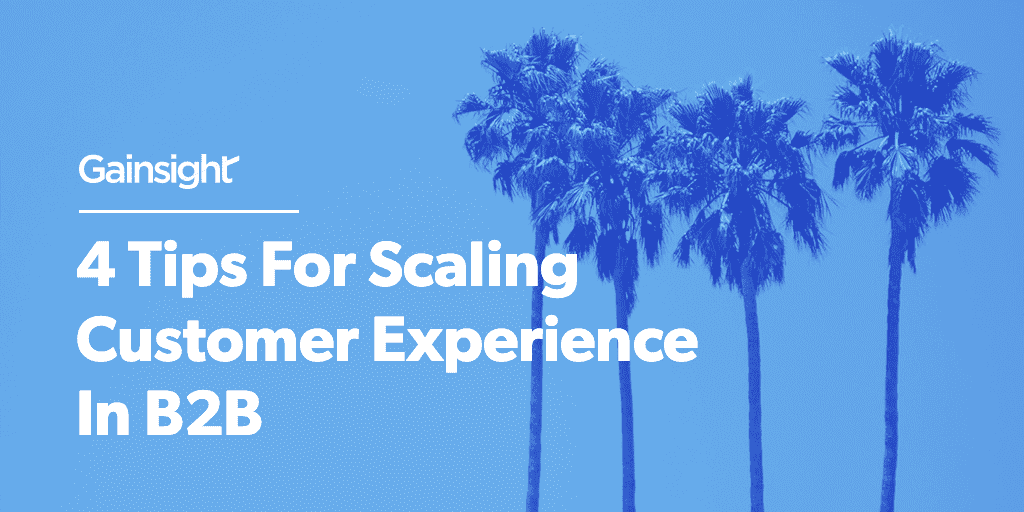Four out of five B2B companies expect to compete based on CX alone. But will they actually? For most of them, the answer is no.
It should come at no surprise that compared to B2C, B2B lags in customer experience (CX). Increased customer expectations, especially when it comes to recurring revenue, mean that B2B companies can’t just drag and drop B2C CX strategies—even mid-touch customers are far too complex and spend far too much in ARR for that to work.
That’s because B2C CX is typically reactive. You capture direct customer feedback and respond when they are upset or leverage it when they’re happy. Benchmark and repeat.
Unfortunately, B2B orgs can’t expect to compete in this reactive model. In order to maintain positive trends, they must:
- Mix direct feedback with indirect and behavioral signals.
- Keep up with complex customer journeys and tailor engagements to multiple stakeholders.
- Identify root causes of dissatisfaction and solve using cross-functional playbooks.
And on top of all that, you need to be concurrently driving desired outcomes in your customer base. Not gonna lie—it’s going to take systems, process, and data.
Tip 1: Keep an eye on account health
B2C CX has traditionally been built around a central axis of responding to customer complaints. We know that won’t scale in B2B, and the reason is clear: CX happens on an individual level, but in B2B, we transact on an account level. Too many B2B CX strategies don’t have a way of correlating individual experiences to overall account health.
You need a process to surface account-level insights out of user-level feedback.
Personalized touchpoint surveys can help prevent “zombie” users by providing context around user behaviors. In turn, this can give you a more in-depth look at specific points within complex customer journeys. Using Gainsight CX, you can then turn this feedback into insights that allow you to bring customer analysis and customer health scores together.
Understanding account health is critical for three reasons:
- It helps you better understand how much of a price increase your customers are willing to bear.
- Taking this information with you will keep you better prepared on how to address potential concerns in discussions about price increases.
- It allows you to identify what parts of the customer journey need to be improved.
Tip 2: Automate customer interactions
Personalized touchpoint surveys can help you identify potential triggers for automated engagements. It’s not enough to engage with your customers one event at a time. Instead, they need to be wined and dined on a regular basis.

Automating customer interactions turns your customer relationship into a series of ongoing engagements that ultimately lead to a higher satisfaction rate. At the same time, automating customer interactions offers you deeper insights into data such as more in-depth segmentation and the ability to predict future interactions.
By taking this information and incorporating it into your CX strategy, you can proactively avoid losing customers during “moments-of-truth” like price increases for example.
Tip 3: Segment and profile
B2B organizations can’t afford to treat every customer the same. While you can use surveys to qualify potential leads with basic info like company size and budget, it’s also important to collect more in-depth info that will give you access to data like:
- What pain points your customers are experiencing
- What job title they hold
- What their short and long-term goals are
Maybe your product can solve their problems, but they’ll never know that if you aren’t able to segment them into different categories and target them with directed marketing campaigns.
By segmenting your customers, you can begin to address price increases based on their pain points and goals. Your customers won’t resist a price increase if they still get tremendous value from your product, but you have to be able to inform them about it in a way that’s relevant to them.
Tip 4: NPS Surveys
Arguably one of the most effective ways to gauge customer satisfaction, NPS surveys provide an answer to a very simple question: “How likely are you to recommend us to a friend or colleague?”
Customers answer this question by selecting a number on a scale of one to ten and are then divided into three groups:
- Promoters: Promoters score 9-10 and are enthusiastic about your product. They’ll help fuel growth by continuing to buy and refer your product to others.
- Passives: Passives score 7-8 and are mostly satisfied. They will continue to buy your product but are vulnerable to competitive offers.
- Detractors: Detractors score 0-6 and are not happy with your product. They’re unlikely to continue buying and can hurt your brand through negative word of mouth.
Sending NPS surveys through your CRM help you collect valuable insights into how your business is doing. You can then set up automated triggers so your CS team can follow up with customers based on their score.
Incorporating NPS surveys into your CX strategy will also help you set internal benchmarks as well as allow you to compare your benchmark score against others in your industry.
In Conclusion
CX isn’t a one event type of deal. If you want to compete with other businesses, a comprehensive understanding of your customers is necessary. It isn’t enough to just receive a promoter NPS score or survey your customers annually anymore.
Now, B2B businesses have to understand signals such as whether end-users are logging in, where users are stalling out, and the root cause of these issues in order to drive x-functional action that leads to success.
A dedicated CX platform allows you to combine feedback with the tools needed to drive engagement to:
- Automate targeted outreach
- Trigger follow-up actions
- Produce deeper insights
Ready to take your CX to a new level? Try out our free demo for Gainsight CX and let us know what you think. 😉
